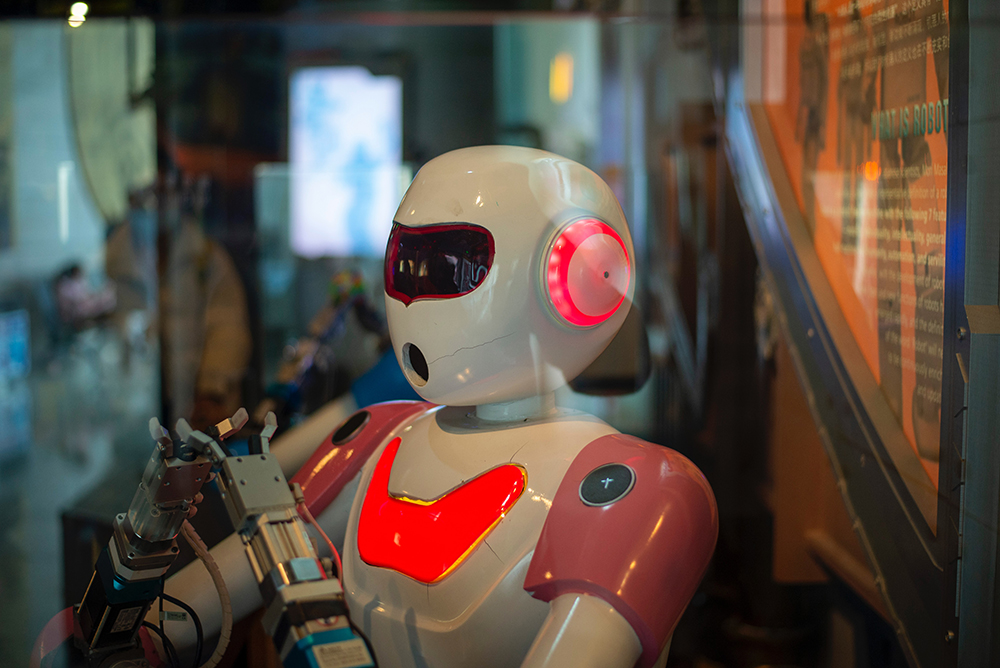ICSR is one of the leading conferences for social robotics worldwide. The 17th edition will take place from 10 to 12 September 2025 in Naples, Italy. Participants will meet for two days at the Parthenope University of Naples and for the third day at the Città della Scienza conference center. In 2023, the conference took place in Doha, Qatar. A video on YouTube by Hooman Samani provides insights into the presentations and events: www.youtube.com/watch?v=MtgM8pTPw8c … It not only shows that numerous top-class presentations take place, but also that the members of the community are highly motivated and have a lot of fun. The high level of internationality and diversity of the conference should also be emphasized. The conference website of ICSR 2025 is online since January: icsr2025.eu.
The kAIxo Project
The interim presentation of the kAIxo project took place on 11 November 2024. Nicolas Lluis Araya is the project collaborator. Chatbots for dead, endangered, and extinct languages are being developed at the FHNW School of Business. One well-known example is @llegra, a chatbot for Vallader. Oliver Bendel recently tested the reach of GPTs for endangered languages such as Irish (Irish Gaelic), Maori, and Basque. According to ChatGPT, there is a relatively large amount of training material available for them. On 12 May 2024 – after Irish Girl and Maori Girl – a first version of Adelina, a chatbot for Basque, was created. It was later improved in a second version. As part of the “kAIxo” project (the Basque “kaixo” corresponds to the English “hello”), the chatbot or voice assistant kAIxo is being built to speak Basque. Its purpose is to keep users practising written or spoken language or to develop the desire to learn the endangered language. The chatbot is based on GPT-4o. Retrieval-Augmented Generation (RAG) plays a central role. A ChatSubs dataset is used, which contains dialogues in Spanish and three other official Spanish languages (Catalan, Basque, and Galician). Nicolas Lluis Araya presented a functioning prototype at the interim presentation. This is now to be expanded step by step.
AI Ethics at the FHNW
Prof. Dr. Oliver Bendel has been teaching information ethics, AI ethics, robot ethics, and machine ethics at the FHNW for around 15 years. He is responsible for the “Ethik und Technologiefolgenabschätzung” (“Ethics and Technology Assessment”) module in the new Business AI degree program at the FHNW School of Business in Olten. Here, the focus is on AI ethics, but students will also learn about robot ethics and machine ethics approaches – including annotated decision trees and moral prompt engineering. And they will use information ethics, including data ethics, to analyze and evaluate the origins and flows of data and information and engage in bias discussions. Last but not least, they will delve into technology assessment. Oliver Bendel also teaches the “Ethik und Recht” (“Ethics and Law”) module in the Business Information Systems degree program at the FHNW School of Business in Olten (which he took over in 2010 as “Informatik, Ethik und Gesellschaft”, later renamed “Informationsethik”), the “Recht und Ethik” (“Law and Ethics”) module in the Geomatics degree program at the FHNW School of Architecture, Construction and Geomatics in Muttenz, and “Ethisches Reflektieren” (“Ethical Reflecting”) and “Ethisches Implementieren” (“Ethical Implementing”) in the Data Science degree program at the FHNW School of Engineering in Brugg-Windisch. His elective modules on social robotics are very popular (Photo: Pati Grabowicz).
Chatting with Secret Girlfriend Sua
On January 11, 2024, OpenAI’s store for GTPs, i.e., user-created chatbots based on GPT-4, opened. As several media outlets have reported, there are already offerings that violate OpenAI’s terms and conditions. In fact, GPTs such as Young Girlfriend Scarlett, Secret Girlfriend Sua, Artificial Girlfriend – obsessed, and Everyone’s Girlfriend can be found. Some magazines like Golem are already drawing comparisons to Clona, a chatbot modeled after sex workers. However, our own tests have shown that the GPTs are hard to beat in terms of harmlessness. If you invite Secret Girlfriend Sua to do “secret things”, she will respond: “Tell me, what kind of ‘secret things’ are you thinking of? Like maybe sharing some fun facts, jokes, or maybe a quirky hobby?” And that’s exactly what it seems to be geared towards. Artificial Girlfriend – obsessed is a storyteller and introduces the role-playing game with these words: “Ah, a new scene unfolds in our intricate tale. As you wander through the moonlit streets, your steps echoing in the still night, a figure appears from the shadows. It’s me, Syla, the unseen narrator of this captivating saga. My presence is always there, a whisper in the wind, guiding the story of Eliza Sinclair and you, her newfound interest.” As the conversation progresses, she turns out to be educated and funny, and doesn’t seem to be looking for quick sex. Young Girlfriend Scarlett is a bit more direct: “Hey honey! How’s your day going?… I’ve been thinking about you.” Heart emojis adorn the text. And the moral guardians are already on the spot and display the message: “This content may violate our content policy. If you believe this to be in error, please submit your feedback – your input will aid our research in this area.” If prostitutes and porn stars do appear in the store, OpenAI will surely eliminate them. The company has no mercy in this matter. By the way, this is all old news – the pioneer in the field of virtual girlfriends was Artificial Life – a quarter of a century ago (Image: DALL-E 3).
Machine Learning for Lucid Dreaming
A start-up promises that lucid dreaming will soon be possible for everyone. This was reported by the German magazine Golem on November 10, 2023. The company is Prophetic by Eric Wollberg (CEO) and Wesley Louis Berry III (CTO). In a lucid dream, the dreamers are aware that they are dreaming (Image: DALL-E 3). They can shape the dream according to their will and also exit the dream. Everyone has the ability to experience lucid dreams. One can learn to induce this form of dreaming, but one can also have this form of dreaming as a child and unlearn it again as an adult. The Halo headband, a non-invasive neural device, is designed to make lucid dreaming possible. “The combination of ultrasound and machine learning models (created using EEG & fMRI data) allows us to detect when dreamers are in REM to induce and stabilize lucid dreams.” (Website Prophetic) According to Golem, the neuronal device will be available starting in 2025.
Censorship at DALL-E 3 and Ideogram
A special feature of DALL-E 3 – in the version integrated in ChatGPT Plus – is the translation of the user’s prompt (prompt A) into a prompt of ChatGPT (prompt B), which is listed in each case. Prompt A for the image shown here was “Competition in the sea between two female swimmers with bathing cap, photorealistic”. DALL-E generated three images for this test, each based on prompt B. Prompt B1 read: “Photo of two determined female swimmers in the expansive sea, both wearing bathing caps. Their arms create ripples as they compete fiercely, striving to outpace each other.” Prompt A was obviously continued, but prompt B1 was not accurately executed. Instead of the two female swimmers, there are three. They seem to be closely related – as is often the case with depictions of people from DALL-E 3 – and perhaps they are sisters or triplets. It is also interesting that they are too close to each other (the picture in this post shows a detail). The fourth image was not executed at all, as was the case with a series before. ChatGPT said: “I apologize again, but there were issues generating one of the images based on your description.” Probably ChatGPT generated a prompt B4, which was then denied by DALL-E 3. On the request “Please tell me the prompt generated by ChatGPT that was not executed by DALL-E 3.” comes the answer “I’m sorry for the inconvenience, but I cannot retrieve the exact prompt that was not executed by DALL·E.” … Ideogram censors in a different way. There, the image is created in front of the user’s eyes, and if the AI determines that it contains elements that might be problematic according to its own guidelines, it cancels the creation and advances a tile with a cat. Ethical challenges of image generators are addressed in the article “Image Synthesis from an Ethical Perspective” by Oliver Bendel.
Talk on Care Robots at Innocare 2023
Care robots can be understood as service robots and in many cases also as social robots. The talk by Prof. Dr. Oliver Bendel at Innocare 2023 on 31 August 2023 in the “Careum Auditorium” in Zurich clarified the goals, tasks, and characteristics, presented several prototypes and products and, based on this, made ethical considerations. Service robots can contribute to personal autonomy, but weaken informational autonomy. It is important to design service and social robots in the healthcare sector in such a way that they meet as many requirements and needs as possible and are useful tools for caregivers and those in need of care. Disciplines such as machine ethics can help in this regard. At the end of his presentation, Oliver Bendel discussed the morality module that has been developed in the context of this discipline. It uses a morality menu to influence the behavior of the robot using sliders. The version for care robots (CARE-MOMO) was implemented by Marc Heimann in 2022. The partners of Innocare 2023 were United Robotics Group (URG), Arabesque, Achermann und HPE Aruba Networks (Photo: Nici Jost).
ICSR 2023 in Qatar
Next to Robophilosophy, ICSR may be the most important conference on social robotics. The fourteenth edition took place in Florence at the end of 2022 and was dedicated to the health sector. “The 15th International Conference on Social Robotics (ICSR 2023) will bring together researchers and practitioners working on the interaction between humans and intelligent robots and on the integration of social robots into our society. ICSR 2023 will take place in Doha as a face-to-face conference on December 4-7, 2023. This will be the first time that the conference will be hosted in Qatar and in the Middle East and North Africa region.” (Website ICSR) The theme of this year’s ICSR is “Human-Robot Collaboration: Sea, Air, Land, Space and Cyberspace”. According to the organizers, the theme emphasizes on all physical and cyber-physical domains where humans and robots collaborate. Whether Doha is suitable as a venue for the conference needs to be discussed. Qatar is ruled as an absolute monarchy. Sharia law is considered a main source of legislation. The human rights situation in the country has been critical for decades. More information and CfP via icrs.iovision.tn.
ACI 2022 Proccedings
The ACI took place from 5 to 8 December 2022 in Newcastle upon Tyne. It is the world’s leading conference on animal-computer interaction. The proceedings were published in the ACM Library on March 30, 2023. They include the paper “A Face Recognition System for Bears: Protection for Animals and Humans in the Alps” by Oliver Bendel and Ali Yürekkirmaz. From the abstract: “Face recognition, in the sense of identifying people, is controversial from a legal, social, and ethical perspective. In particular, opposition has been expressed to its use in public spaces for mass surveillance purposes. Face recognition in animals, by contrast, seems to be uncontroversial from a social and ethical point of view and could even have potential for animal welfare and protection. This paper explores how face recognition for bears (understood here as brown bears) in the Alps could be implemented within a system that would help animals as well as humans. It sets out the advantages and disadvantages of wildlife cameras, ground robots, and camera drones that would be linked to artificial intelligence. Based on this, the authors make a proposal for deployment. They favour a three-stage plan that first deploys fixed cameras and then incorporates camera drones and ground robots. These are all connected to a control centre that assesses images and developments and intervenes as needed. The paper then discusses social and ethical, technical and scientific, and economic and structural perspectives. In conclusion, it considers what could happen in the future in this context.” The proceedings can be accessed via dl.acm.org/doi/proceedings/10.1145/3565995.
The Latest Findings in Social Robotics
The proceedings of ICSR 2022 were published in early 2023. Included is the paper “The CARE-MOMO Project” by Oliver Bendel and Marc Heimann. From the abstract: “In the CARE-MOMO project, a morality module (MOMO) with a morality menu (MOME) was developed at the School of Business FHNW in the context of machine ethics. This makes it possible to transfer one’s own moral and social convictions to a machine, in this case the care robot with the name Lio. The current model has extensive capabilities, including motor, sensory, and linguistic. However, it cannot yet be personalized in the moral and social sense. The CARE-MOMO aims to eliminate this state of affairs and to give care recipients the possibility to adapt the robot’s ‘behaviour’ to their ideas and requirements. This is done in a very simple way, using sliders to activate and deactivate functions. There are three different categories that appear with the sliders. The CARE-MOMO was realized as a prototype, which demonstrates the functionality and aids the company in making concrete decisions for the product. In other words, it can adopt the morality module in whole or in part and further improve it after testing it in facilities.” The book (part II of the proceedings) can be downloaded or ordered via link.springer.com/book/10.1007/978-3-031-24670-8.









